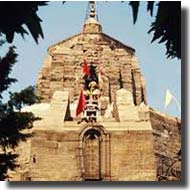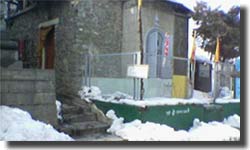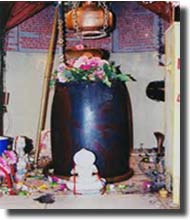Location :
The temple as it is today has undergone many repairs throughout its life. Ever since under the rule of Lalitaditya and then repairs were undertaken by Zain-ul-Abideen after the temple got damaged in an earthquake. The repairs were also carried out during the Governorship of Sheikh Mohi-ud-Din. Maharaja Gulab Singh, a Dogra ruler, who is credited for the stone steps that form a part of the passage to the shrine. In 1925, the electrification of the temple was done.
Significance of the Temple
The Shankaracharya temple has gained great importance, not only from the point of view of religion, but even from architectural viewpoint. It has a high octagonal platform supporting, approached by a flight of approximately hundred steps.The sidewalls of these steps once bore some valuable inscriptions. Even there exists also a Persian inscription inside the temple, dating back to Emperor Shahjahan's rule.
The main surviving shrine of the temple is consisting of a circular cell, which provides a magnificent view of the valley below. The inner chamber of the Shankaracharya temple is today covered with a modern ceiling. The great philosopher Shankaracharya has stayed here when he visited Kashmir to revive Sanatan Dharma.

The temple of Shankaracharya is located on the top of a detached ridge of an igneous rock and along with conical hill rising behind the Boulevard beside the Dal Lake. This hill is known as Shankaracharya Hill and a temple is said to have been first built here by the son of the Mauryan King Asoka, the great in 2nd century BC. The temple serves as a landmark of Srinagar city on the summit of the Gopadari. According to renowned Archaeologist, R. C. Kak, who has been researching the hill “Neither the hill nor the Temple preserves its ancient name”.The temple could be reached by two hundred and forty three steps with twenty-three landing and the approximate height is 550ft or 167.68 meters from the end of the road to hill, before one reaches the temple platform.
The Sunrise and the Sunset, birth and death, etc. on the earth are controlled by a Universal power regulating the earth and living species. The temple is known in such terms as devalaya, sivalaya and devayatana. The life is therefore installed in the form of the deity in the sanctum which is known as grabhagriha or the house of the womb. Thirteen steps with a railing leads to the dwarf wall at the plinth level, enclosing the parapet wall
The main shrine consists of a circular Cella. The interior of the sanctum is covered by a ply board ceiling concealing the flat sandstone slabs which are supported by two lintels bearing the load on four eight sided column of stone in the centre. The lower course of the ceiling is still extant in its original shape. There is a large oval shaped Shiva Lingam with reddish black stone probably brought from the Naramada River valley in Madhya Pradesh of Central India. The south-west column of the temple bears two inscriptions of Mughal Period. The temple resembles the interior plan of a large temple at Ladhuv (District Pulwama) in the Valley. The brick roof supporting the slopping stone slabs probably has been added in the 19th century.

Shankaracharya temple is a nationally Protected Monument under the Archaeological Monument, Sites and Remains Act, 1958 and maintained by the Archaeological Survey of India. The temple is located in the valley under high security zone and hence no camera and mobile is permitted on the top. The night view from terrace of the Temple is mesmerizing and enchanting, with yellow, white and saffron lights twinkling city below. The view is a wonderful experience with white snow clad mountain ranges in the background, yellow and white light of Houseboats reflecting in water of Dal Lake, in a series of rows.
Who build the temple and when
It is believed that Raja Gopadatya got the temple constructed in 371 BC, giving it the name of Gopadri. The great philosopher Shankaracharya has resided here when he visited Kashmir to revive Sanatan Dharma. This incident, which took place ten centuries ago, led to the renaming of the temple as the Shankracharya temple.
The main building of Shankaracharya temple is about 30 feet high. The interior part of the temple houses the sacred Lingam of Lord Shiva. In the year 1961 April 20th, near the temple, the white marblr bust of Adi Shankaracharya was installed by the J & K Dharmarth Trust. Just behind the temple is a small marble tank built with slab stones. 265 cotta-stone steps have been raised for the convenience of pilgrims and the devotees visiting shrine every day. The holy Shankaracharya temple is well maintained and kept under the supervision of the President of the Trust Mr. Divakar Singh.
How to reach the Temple

The nearest Airport is approx. 25 Kms away in Badgam Dist, for the temple. This Airport is connected with major cities of India and the nearest Rail Head is at Jammu which is 300 Kms away. The Highway NH1A connects the Kashmir valley with India. Every sort of transport to suit every budget from Buses to Taxis ply on this Highway. It takes around 10 to 12 hours to cross this mountainous road which crosses some beautiful spots and the famous Jawaharlal Tunnel linking Kashmir Valley with India.
Time to Visit
Best time to visit the Shankaracharya temple is during the month of September-October or early winter.
Accommodation Facilities at the Temple
These are some of the accommodation facilities available in Jammu & Kashmir for the Piligrims.
|
Nearby tourist places to Shankaracharya Temple
Badrinath Kedarnath Rishikesh Srinagar |
 |
Kashmir Travelport offers good and facilitated services of recognized transport companies based in Kashmir Valley. Other than state transport company which operates within the inter-city and inter-district buses, there are many private transport associations providing services of small and medium vehicles.
Such transport services include Car Rentals, Airport and Hotel transfers, Sightseeing Tours and Getaway Tours. Some of the recognized Taxi and Tour Operator Associations and Stands are responsible for providing transportation facilities and services. There are also private companies which run small and medium vehicles including Ambassador Cars, Tata Sumos, Mahindra Scorpios, Taverns, and Omni mini vans, Tata Indicas, Wingers, Tempo Travellers and more.



